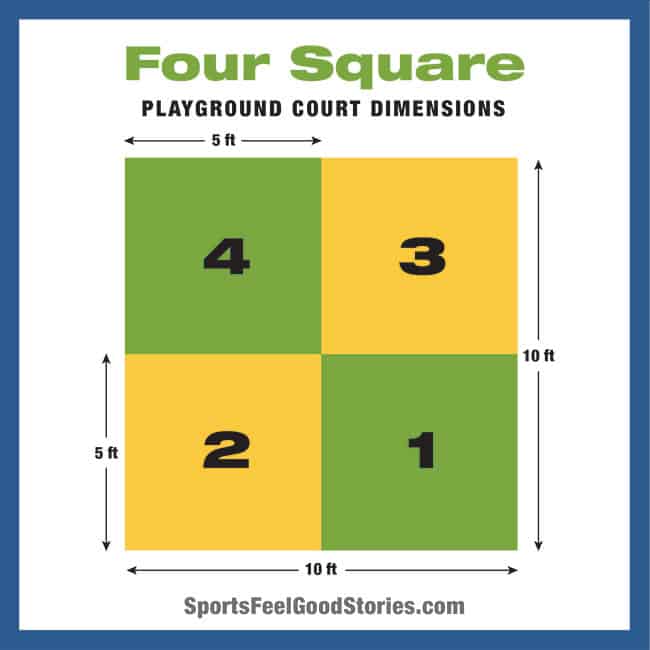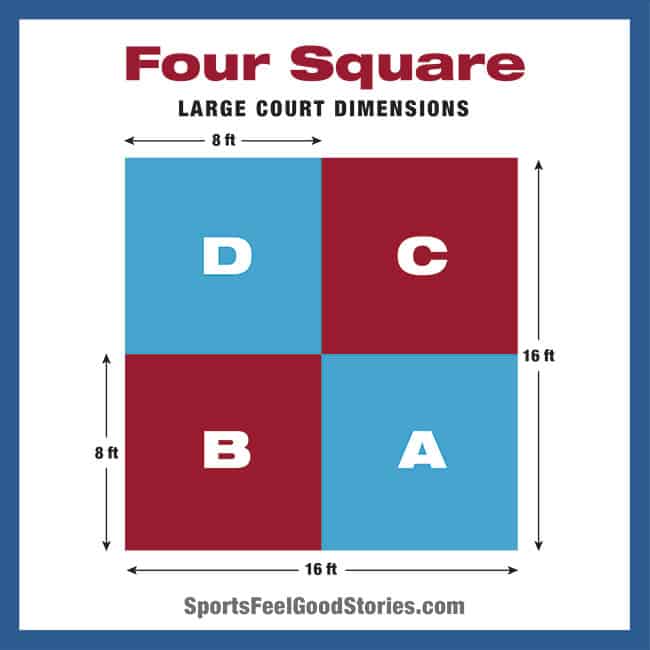The game of Four Square requires at least four players. The court consists of four large squares (usually 5′ by 5′ for younger players) that create the playing area. There is no official size for a court, but the courts typically range between 10-20 feet and must be square. Four quadrants divide the court, and each of the four players occupies one quadrant.
How To Play Four Square
The game requires a semi-hard playing surface (a square court) and a rubber ball. The ball is typically a red rubber playground ball, much like the ones used for kickball. The ideal surface can be a blacktop, a tennis court, concrete, or a gymnasium floor.
The court lines can be drawn with chalk or marked with masking tape. Each quadrant is labeled: J, Q, K, and A for Jack, Queen, King, and Ace. Or, they can be numbers one through four or assigned the first four letters of the alphabet: A, B, C, and D.
The J stands for Jack and is the lowest rank. The royalty ranks ascend to Queen, King, and Ace, always to become the Ace by advancing up the ranks. The Ace gets to start each turn with the ball. The game begins with four players in squares. Each player moves up a square if a player in a higher-numbered square loses a point.
A turn begins when the Ace serves. The service consists of bouncing the ball once in your square, and then sending it into another square. It must bounce once inside the lines in the receiving square. The Ace is often required to serve into the square located opposite (diagonal) to their own – so many times. This square is designated to be the Jack.
The Ace is usually the only square featuring a triangle in its back is where the server stands. The other squares can be assembled in a variety of ways, either clockwise or counterclockwise. Or, as previously stated, with Jack directly across from the Ace so that Jack is always the recipient of the first serve.

Standard Four Square Rules of the Game
- The object of the game is for each player to advance to the highest square by eliminating players in higher squares. Reaching the server’s position is the goal.
- Typically, there are no officials for the game. Rather, the players make their own line calls, handle any disagreements, and settle their own disputes.
- Serving the ball — The server must complete a serve with at least one foot behind the service line. The serve is the first play of the game.
- All balls must be hit underhanded. A player touches the ball with one or two hands.
- The ball must bounce one time, and only one time, in your square before a player hits it underhanded. A receiving player can return the ball to the server or any other square. If the ball bounces a second time in a player’s square, that player loses the point. The second bounce triggers the stoppage of play.
- When a player loses a point, each player rotates up a position. The person who lost the point – the loser – goes to the Jack square – the last square – or, if other players are waiting to enter the game for their next turn, to the back of the line. Essentially, all the remaining players advance.
- If a ball hits an interior line, it’s considered “out,” and the player is eliminated. If it hits an exterior line, it’s considered “In” or good.
More Rules
- No carrying or holding the ball. The ball must be struck much like in volleyball; only all shots are underhanded.
- The server asks, “Are you ready?” before each serve.
- The server bounces the ball and hits it underhand to one of the squares. The returner lets the ball bounce in his or her square before hitting it underhanded to another square. Play continues until an error is made. The player making the error goes to the lowest square, Jack in our example, or to the back of the line if there are more than four players.
- Players rotate up in the foursquare area if the player making the error is ahead of them in rank. If there are more than four players, a new player will enter at the conclusion of a point.
- If you’re scoring points, only the Ace can score. So, if any other player makes an error, the Ace gains one point. You can add up scores and play to 10, 15, or 21 points. The first player to hit the agreed-on total wins!
- All inside lines are out-of-bounds. All outside lines are considered in play.
- Review all the rules with all the players before the game to prevent a dispute of any kind.
- One variation of the game enables the player in the top square to have a special privilege. They can make special rules, e.g., all skilled players must hop on one leg while playing. These rules set by the player in the top square become part of the game while that player maintains the top position. These customized rules can be ridiculous rules or just slight variations. Typically, the top square player establishes rules that favor their own style of play.
Game Play — How to Play Four Square
This competitive game is played on a 16-foot square court that is divided into four smaller squares.
Because foursquare is such a social game, the traditional etiquette is to announce when a service is coming. The serve sets the game in full motion. The game will continue until someone makes a mistake by either failing to hit the ball, sending the ball out of bounds, or allowing the ball to double-bounce in one’s square.
When in play, there are specific rules about how you can and cannot bounce the ball. Catching, carrying, cupping, or trapping the ball is illegal, as hitting the ball with anything other than the hands. The player in violation is out. Hitting a ball that bounced in someone else’s square is called poaching and results in the offender being out.
When a person is out, they leave the court and head to the back of the line (if there are more than four players). The active players either stay in place or advance up the ranks (depending on the level of the person who just got out). Next in line enters Jack.
There are two main ways to win four squares. One is the traditional recess way: whoever is Ace when the time is up is the champion. The other is to count points as Ace. Only the Ace can earn a point. Whoever has the most points from the Ace position wins.
You might like Kickball Tips and Tricks.

Strategy and Tactics
Although the game may seem simple, there are a lot of strategies that go into it.
Standing outside (behind) your square is a common strategy for receiving the service from the Ace (as long as you are not interfering with anyone else’s square). This allows the recipient to have a lot of room to work within their square while also ensuring a hard serve can’t sneak past. It will enable the receiver to lunge into the return, putting a little extra power behind their strike.
Aim to eliminate the higher-ranked squares. The Queen should focus on eliminating the King (or Ace) rather than Jack. Likewise, the King should be focused on eliminating the Ace. There really is no incentive to force a lower-ranked position to lose a point unless you’re the Ace.
Note: If you have any tips on playing four square, please let us know via the contact page.
Four Square Tips To Winning
- Like all games, a little deception is always a welcome move. One common deception tactic is the no-look pass. Another is the fake-out, where a player motions to one side and then plays to the other.
- A little spin on the ball can be tough to pull off, but the results are well worth it. Just be careful not to accidentally carry the ball while attempting to put a spin on it.
- Don’t forget the no-look shot. Appear as if you’re aiming at one square, but direct the ball to the highest-ranking square.
- The change-up. A classic move across any game of strategy and skill. It can have many forms, but the premise is always the same: lead with one move, then do the opposite. The most common forms of this are in a “war” between two players on the court, where the ball is continually sent between the two of them. A change-up would look like if Jack and Queen were a war, and then suddenly, the Queen hit the ball at the Ace when the Ace wasn’t ready.
- Another change-up is to send a series of hard fastballs at the other players and then unexpectedly drop a soft, short ball into someone’s square. The hard hits can push a player deep back or out of their square entirely, which leaves them vulnerable to a shallow, finessed ball.
- The spike. Be careful not to carry the ball, or it can backfire, but properly spiking the ball can send the ball bouncing over another player’s head, which can be nearly impossible for them to return. And when the spike doesn’t work, there’s always the fake spike!
Fancy Footwork for 4 Square
Regarding your footing, the same rule applies in four squares as it does in life: don’t get caught flat-footed. Stay on your toes and stay loose. Not only does standing flat-footed put you at a physiological disadvantage, but it also puts you at a social disadvantage because you will look; like an easier target, and chances are someone will notice and place their hit accordingly.
Speaking of flat-footed, it is illegal to send the ball directly into someone else’s feet/ legs, but you can send it very close. If you notice someone is standing flat-footed, a ball aimed at the ground right in front of their toes is probably all you need to send them off the court.
It may take time and experience before developing the ability to read your opponents’ stances, but a few key signs to look for and exploit are: if they are standing too far forward, hit the ball behind them. If they are focused on another player, use their focus against them. If a player is particularly one-hand dominant, hit the ball to their less-dominant hand.
Four Square Variations
While the core rules are universal, many “backyard rules” are also fairly standard. It is necessary to disclose any variations if allowed, ahead of time so everyone is aware. These rules can vary from being fun and silly to downright ridiculous. As a result, many of them are not well suited for competitive play.
Cherry Bomb — 4 Square Variation
This is the most common expansion of the standard rules. A cherry Bomb is when a player does a massive spike (often a jump spike) directly into the opponent’s square. They are required to yell out “Cherry Bomb!” before they finish the spike. Cherry Bomb is usually limited to one use per turn for each player. Sometimes it is only the Ace that can use the ‘Bomb.
Around the World — 4 Square Variation
The “Around the World” variation requires the ball to go one full rotation and back to the player that called out: “Around the World.” Each player must hit the ball to their right until all four players have touched it. Then, play returns to normal.
Baby Bomb — 4 Square Variation
This is the Cherry Bomb fake-out. Unlike the Cherry Bomb, the Baby Bomb is softly bounced into someone square at the center of the court. This usually requires them to quickly transition from the back of the square to the front of it. Sometimes called a Fairy Bomb.
Overhanded Play: 4 Square Variation
Instead of forbidding overhanded hits, all players may hit the ball overhanded or underhanded.
History of Four Square Game
Not much is known about the specific origins of Four Square. However, an American teacher’s manual from 1953 described the game in full with all the same rules still used today. This also explains why most people learn about the game at school during recess.
Four Square is also directly related to Two Square. The rules are the same, except there are only two squares and two players. Two square was often used when only 2 or 3 players were available or only a sidewalk was available to play on (using two concrete squares and their lines/ the grass as the boundaries).
Box Ball is commonly believed to be the predecessor to Four Square. Box Ball can be traced back to World War I, when a tennis ball was used. But as the game evolved and became popular during recess, a bigger rubber ball was more suitable for children.
Fun Facts
- The longest game of Four Square ever recorded lasted 34 hours. It was played by a group of Massachusetts high school students and community members.
- Russian Four Square is centered around becoming the Tzar (the Ace). Your goal in this position is to quell and vanquish the uprisings against you (the other players). Each player has a number of points and loses once their points are eliminated.
- The game of Four Square dates back to at least the 1950s.
- “King” is what Four Square is called in Sweden.
- Four Square is a popular recess sport for a few reasons. The setup is quick. Many games can be played in a short amount of time. And, finally, not a lot of equipment is necessary.
So, find a ball, some chalk, or masking tape and teach someone you know how to play four square.
By Steven Henry
Steven writes about sports, culture, and history.
Overtime
You’re on the How to Play Four-Square: Four Square Rules, Strategies, Fun Facts page.
You might like:
Hopscotch: Rules, Tips, and Fun Facts
